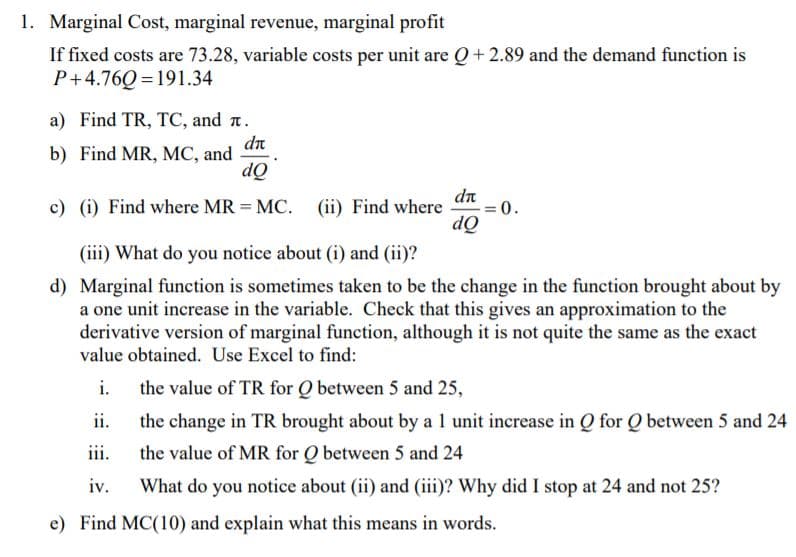1. Marginal Cost, marginal revenue, marginal profit If fixed costs are 73.28, variable costs per unit are Q+ 2.89 and the demand function is P+4.76Q =191.34 a) Find TR, TC, and n. dn b) Find MR, MC, and Õp c) (i) Find where MR = MC. dn (ii) Find where 0. dQ (iii) What do you notice about (i) and (ii)?
1. Marginal Cost, marginal revenue, marginal profit If fixed costs are 73.28, variable costs per unit are Q+ 2.89 and the demand function is P+4.76Q =191.34 a) Find TR, TC, and n. dn b) Find MR, MC, and Õp c) (i) Find where MR = MC. dn (ii) Find where 0. dQ (iii) What do you notice about (i) and (ii)?
Managerial Economics: Applications, Strategies and Tactics (MindTap Course List)
14th Edition
ISBN:9781305506381
Author:James R. McGuigan, R. Charles Moyer, Frederick H.deB. Harris
Publisher:James R. McGuigan, R. Charles Moyer, Frederick H.deB. Harris
Chapter10: Prices, Output, And Strategy: Pure And Monopolistic Competition
Section: Chapter Questions
Problem 9E
Related questions
Question

Transcribed Image Text:1. Marginal Cost, marginal revenue, marginal profit
If fixed costs are 73.28, variable costs per unit are Q+2.89 and the demand function is
P+4.76Q = 191.34
a) Find TR, TC, and n.
dn
b) Find MR, MC, and
dQ
dn
c) (i) Find where MR = MC. (ii) Find where
0.
dQ
(iii) What do you notice about (i) and (ii)?
d) Marginal function is sometimes taken to be the change in the function brought about by
a one unit increase in the variable. Check that this gives an approximation to the
derivative version of marginal function, although it is not quite the same as the exact
value obtained. Use Excel to find:
i.
the value of TR for Q between 5 and 25,
ii.
the change in TR brought about by a 1 unit increase in Q for Q between 5 and 24
iii.
the value of MR for Q between 5 and 24
iv.
What do you notice about (ii) and (iii)? Why did I stop at 24 and not 25?
e) Find MC(10) and explain what this means in words.
Expert Solution
This question has been solved!
Explore an expertly crafted, step-by-step solution for a thorough understanding of key concepts.
Step by step
Solved in 4 steps

Knowledge Booster
Learn more about
Need a deep-dive on the concept behind this application? Look no further. Learn more about this topic, economics and related others by exploring similar questions and additional content below.Recommended textbooks for you

Managerial Economics: Applications, Strategies an…
Economics
ISBN:
9781305506381
Author:
James R. McGuigan, R. Charles Moyer, Frederick H.deB. Harris
Publisher:
Cengage Learning

Microeconomics: Private and Public Choice (MindTa…
Economics
ISBN:
9781305506893
Author:
James D. Gwartney, Richard L. Stroup, Russell S. Sobel, David A. Macpherson
Publisher:
Cengage Learning

Economics: Private and Public Choice (MindTap Cou…
Economics
ISBN:
9781305506725
Author:
James D. Gwartney, Richard L. Stroup, Russell S. Sobel, David A. Macpherson
Publisher:
Cengage Learning

Managerial Economics: Applications, Strategies an…
Economics
ISBN:
9781305506381
Author:
James R. McGuigan, R. Charles Moyer, Frederick H.deB. Harris
Publisher:
Cengage Learning

Microeconomics: Private and Public Choice (MindTa…
Economics
ISBN:
9781305506893
Author:
James D. Gwartney, Richard L. Stroup, Russell S. Sobel, David A. Macpherson
Publisher:
Cengage Learning

Economics: Private and Public Choice (MindTap Cou…
Economics
ISBN:
9781305506725
Author:
James D. Gwartney, Richard L. Stroup, Russell S. Sobel, David A. Macpherson
Publisher:
Cengage Learning


